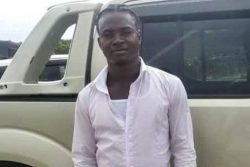With major questions still to be answered about the Lindo Creek killings, visitors to the camp last week were shocked to find what appeared to be human bones at the site, almost certainly some of the remains of the eight miners who were brutally murdered there in June last year.

Amidst the ashes and pebbles in one portion of the camp human bones, some charred, a few bleached white by the sun, lay scattered. Rusted machinery, which looked ready to be put into operation at any time, stood waiting, a silent memorial to those who were killed.
“It’s far beyond touching, you understand, real upsetting, they ain’t get no real funeral nothing, the bones just bun,” Reon (not his real name), a close friend of several of those who died at Lindo Creek said. He was supposed to have been at the camp at the time the killings occurred but was not, and had travelled there in an attempt to find closure. No relatives have been to the site since it was closed.
The forest was slowly encroaching on Camp Lindo and weeds had grown up around some of the machinery. Yellow police tape, now torn and ripped by the elements, surrounded the site and pots in haphazard positions and scattered dishes told only part of the story of what had happened there. Several zinc sheets and some wood indicated where a shed had once been.
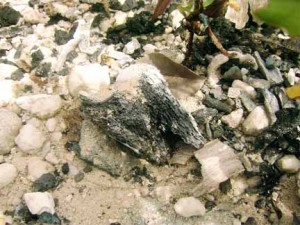
The set-up of the machinery conveyed the impression that operations could restart at any moment. A lavador, a machine which is used to separate the diamonds from the pebbles, sat at the edge of the camp, and the engine started after several attempts. Here too there were large pieces of weathered tarpaulin and underneath were a pair of long boots, some sifters, underwear and shoes, all ravaged by the weather.
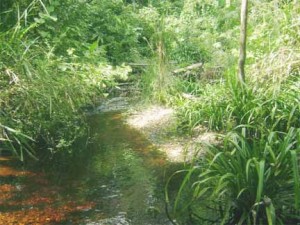
A short distance away, close to the mining pit, a dredge was sitting, together with several rusted drums. What appeared to be a lubricant bottle and a brush were lying at the base of one of the drums and in the mining pit were several pieces of tubing. Bits and pieces of machinery lay nearby. Pipes that connected each piece of equipment were still in place, though weeds had grown over some of them. The old rusted lavador stood close to what had once been the living quarters.
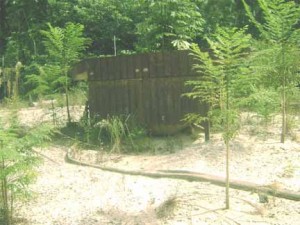
Fragments of burnt tarpaulin, tools, rusted spoons, broken toothbrushes, the charred upper portion of a pair of long boots, condoms, charred bones and ashes indicated where the bodies of the miners had been burned. There were many pieces of bone at this spot, some of them just slivers, so that it was impossible to tell where they could have come from. But there were a few others that were almost whole.
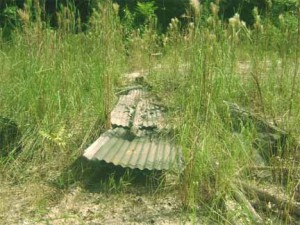
“This is de skull cap,” Kerwin (not his real name) one of the persons on the trip said, holding up a small, flattish piece of bone with a crack in the middle. He picked up the more discernible pieces of bone reverently and placed them in a pile. Grass was beginning to reclaim the site where the bodies had been burned. There was little ash but yet more slivers of bone could be discerned among the pebbles. There was silence as the small party examined the site. It seemed inconceivable that it was here eight bodies had been set on fire. Reon questioned whether the bones should be touched. “You doan study, yuh ga pick um up,” Kerwin responded.
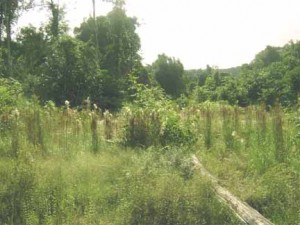
A short distance away, oil dripped from an almost hidden pump situated close to the waterside. A fuel container was still connected to it via a piece of tubing, and a battery was located close by with one of the points still attached. Plants were growing in a water-filled bucket. It appeared as though the men had been preparing for further work when everything was halted.
While it was not physically manifested, there was a palpable sense of great emotion. Kerwin spoke of ‘Tall man,’ and gathered some of the bones and buried them. “Alright Tall Man, rest in peace mi buddy…” he said. ‘Tall man’ was Dax Arokium.
Dax and seven others, his uncle Cedric Arokium, Compton Speirs, Horace Drakes, Clifton Wong, Lancelot Lee, Bonny Harry and Nigel Torres were working at the site a year ago. On June 21, 2008, after receiving reports that the men had been killed, Leonard Arokium, owner of the diamond-mining operation went there and discovered the burnt bones and skulls. He insisted that the Joint Services had killed the men, an accusation which the lawmen have strenuously denied. The Joint Services had been in the area at the time, hunting notorious criminal Rondell ‘Fineman’ Rawlins and his gang. Rawlins has since been killed and police say that he was responsible for the massacre at Lindo Creek. However, relatives remain firm in their opinion about who committed the act.
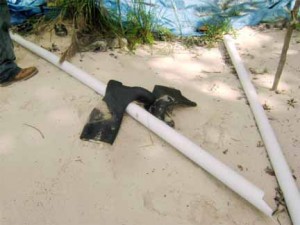
After Arokium’s gruesome discovery, law enforcement officials went to the site and removed the remains. They had sent these to Jamaica for DNA testing but no results have been released as yet.
Arokium said that he was surprised there were still bones at the site. “I thought the area was well cleared up. I thought when the DNA people went, they would have removed all the bones, skulls, everything,” he said. The mining camp owner said that he didn’t know what he would do with the bones, and that the Commissioner of Police was responsible for the investigations.
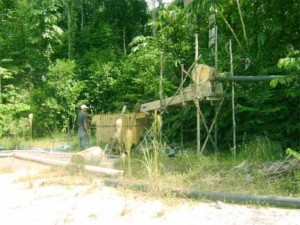
Crime Chief Seelall Persaud, when contacted on Friday about the discovery of bones and other articles at the camp site, said that the scene had been processed by the Guyana Police Force and the forensic team from Jamaica.
In addition, last July, a three-man investigative team from Trinidad visited the country and after two attempts had been able to visit the mining site where one local investigator said they “worked.”
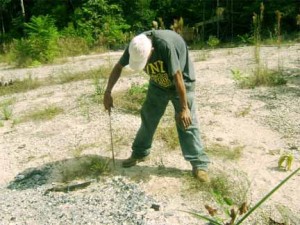
It is not easy to get to Camp Lindo. The site, located on the banks of tiny Lindo Creek in the south-east of Guyana, is close to the Berbice River. To get there overland from Georgetown, one has to travel to Linden, then to Ituni and after that, along the UNAMCO road – a long, dusty, potholed trail in the forest, which is a seven hour journey at best. Vehicles cannot reach the camp, which is over a hill and surrounded by thick forest.
After leaving the UNAMCO road, the path which leads to the camp is overgrown; trees have fallen across the tiny trail and half-rotted logs form bridges across small ravines, streams and the Lindo Creek itself.
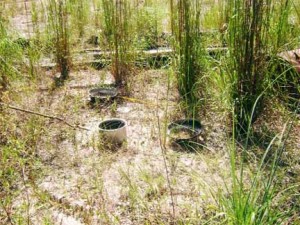
Half-way to Camp Lindo, there is an old camp, now covered in weeds, where the slaughtered miners had lived before. Half-dry Lindo Creek runs through it, and there are fruit trees here. At least five weeks before being killed, the miners had moved from this place to Camp Lindo to be closer to their operations. From this point, the meandering Lindo Creek has to be crossed and re-crossed several times, while huge fallen trees block the path and a hill has to be climbed. The path is overgrown and vegetation has to be hacked away, and it is only by chance that the camp is stumbled upon.
After the incident, persons who had operations in the area moved out. Some are slowly moving back. There are Brazilians working on the right bank of the Berbice River and a miner has expressed interest in re-starting operations in the area.
Leonard Arokium said that he did not know what he would do with the site as he was not too keen to go back. He said that the possibility existed that he may get people to work there, noting that the equipment was valuable. “A decision still has to be made… it would be hard for them [relatives] to go back and work there… they really went there for closure,” he explained. He said that he could not “handle” going back to the site and looking after the equipment.
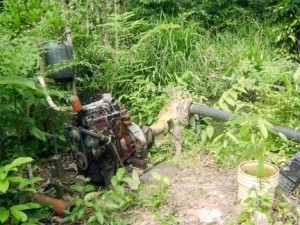
Closure is what relatives want. But the DNA results are yet to be made available. In December, Commissioner of Police Henry Greene said that partial results of the DNA samples had confirmed that at least one of the men had died at the location. He would not say, however, which one of the victims had been identified. In addition, a few weeks ago, Deputy Commissioner of Police of Jamaica Charles Scarlett, while attending the Association of Caribbean Commissioners of Police (ACCP) conference here, suggested that the results would take some time, since Jamaica’s forensic lab was in for “special treatment.” He was unable to comment specifically about the Lindo Creek case but promised to look into the matter and then hopefully pass on a report to Commissioner Greene.
Crime Chief Persaud was asked if there had been any feedback from the Jamaican authorities. He said that he was unaware if there had been any communication, but said that the best person to answer that was the Commissioner of Police Henry Greene.
In the meantime, the horrific crime is yet to be explained to the satisfaction of some. A forensic team from Trinidad had come to the preliminary conclusion on the basis of tests of shells found in the area that the killings had been carried out by the Rawlins gang. Skeptics have said that ballistics tests will not prove anything, as shells could have been planted at the site by persons who had free access to it.





